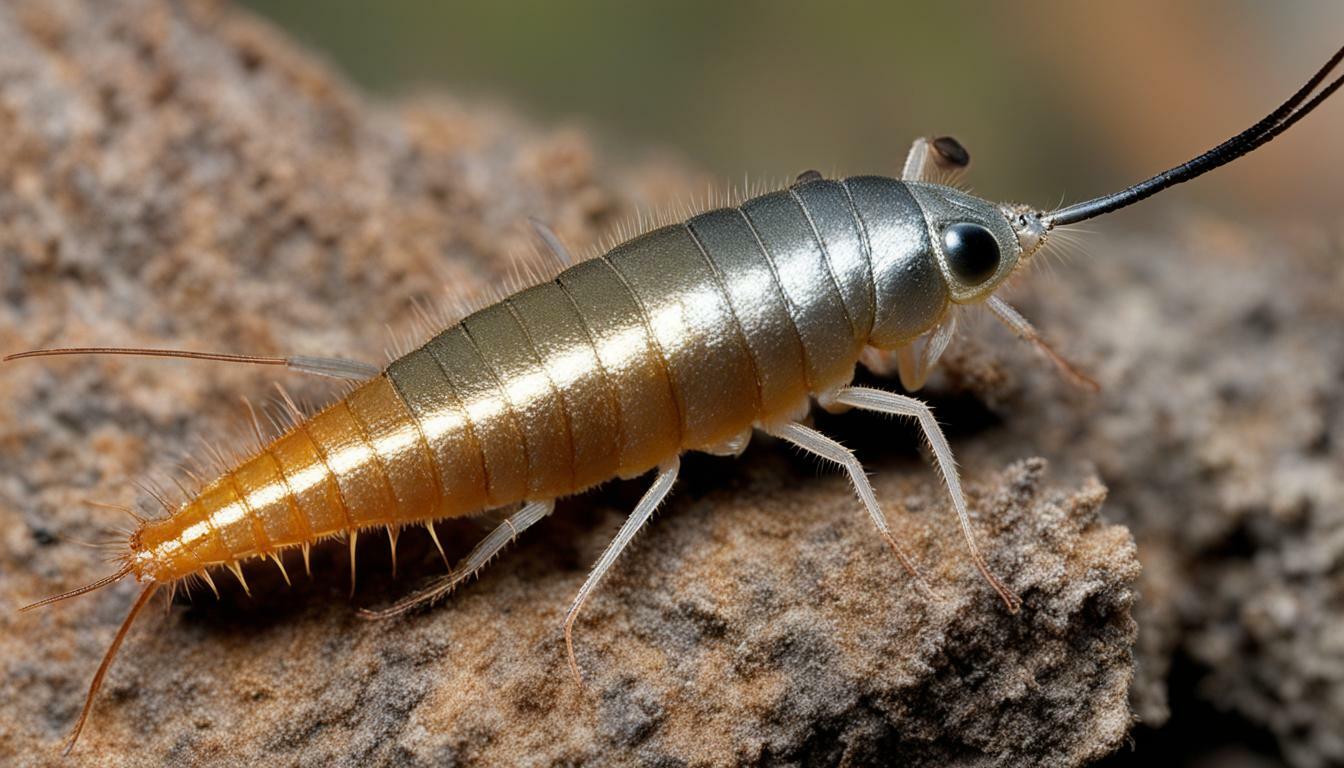Have you ever noticed small, silver-colored insects scurrying across your floor or walls? These pests may be silverfish or firebrats, two similar-looking bugs that can often be mistaken for one another. While they may seem identical, silverfish and firebrats have distinct characteristics that set them apart.
- Silverfish have a more slender, elongated body shape compared to the flatter, wider shape of firebrats.
- Both pests prefer warm, humid environments, but silverfish are more commonly found in damp areas like basements and bathrooms, while firebrats are often found in areas with higher temperatures like attics and near hot water pipes.
- Silverfish are known for their destructive feeding habits, while firebrats primarily feed on organic debris and other insects.
Understanding the difference between these pests is crucial in determining the best course of action for pest control. In the following sections, we will explore the similarities and differences between silverfish and firebrats, their characteristics, and effective methods for prevention and extermination.
Key Takeaways:
- Silverfish and firebrats are two similar-looking pests with distinct differences.
- Silverfish have a slender, elongated body and prefer damp areas, while firebrats have a wider, flattened body and thrive in warmer environments.
- Silverfish are known for their destructive feeding habits, while firebrats primarily feed on organic debris and other insects.
Similarities between Silverfish and Firebrats
Although silverfish and firebrats may look very similar at first glance, they actually share a number of characteristics. Both species are nocturnal and thrive in warm and humid environments. They are known to survive for long periods without food or water and can be difficult to detect due to their small size and elusive nature.
One of the most notable similarities between these two pests is their diet. Silverfish and firebrats both feed on starchy materials such as paper, glue, and textiles. They are also attracted to damp areas, making them common in bathrooms, kitchens, and basements.
In terms of physical appearance, both silverfish and firebrats are flat and elongated, with six legs and two antennae. However, silverfish are typically silver or gray in color and have a distinctive carrot-shaped body, while firebrats are brown and have a more oval-shaped body.
Despite these similarities, there are also several key differences between silverfish and firebrats that set them apart. Read on to learn more in the next section.
Characteristics of Silverfish and Firebrats
While silverfish and firebrats may look similar to the untrained eye, there are distinct differences that set them apart. By understanding their characteristics, you can identify which pest you may be dealing with.
Silverfish Characteristics:
| Physical Attributes | Behaviors |
|---|---|
| Silver-gray color with a teardrop-shaped body | Nocturnal and move quickly |
| Long antennae and three bristles on their back end | Prefer damp, humid environments |
| Can grow up to 0.75 inches long | Feed on starches, sugar, and other carbohydrates |
Firebrats Characteristics:
| Physical Attributes | Behaviors |
|---|---|
| Light brown color with a flat, elongated body | Nocturnal and move quickly |
| Two long antennae and three long tail-like appendages | Prefer dry, warm environments |
| Can grow up to 0.5 inches long | Feed on a variety of materials, including books, fabrics, and paper |
By understanding these distinguishing features, you can effectively identify which pest you may be dealing with, allowing for proper control and prevention methods to be put in place.
Silverfish and Firebrats Infestations: Prevention and Extermination Methods
Preventing a silverfish or firebrat infestation is much easier than having to deal with one. Below are some helpful prevention tips:
- Keep your home clean and free of clutter, as silverfish and firebrats thrive in areas with debris and dust.
- Ensure proper ventilation in your home, as high humidity levels attract these pests.
- Seal off any cracks or crevices in your walls, doors, and windows to prevent entry.
- Store food in airtight containers, as both silverfish and firebrats are attracted to food sources.
If you suspect an infestation, there are several methods for exterminating silverfish and firebrats:
| Extermination Method | Description |
|---|---|
| Boric Acid | This method involves sprinkling boric acid in areas where silverfish and firebrats are present. The acid poisons them when ingested. |
| Diatomaceous Earth | This natural pesticide is made up of fossilized diatoms and can be sprinkled in affected areas. It works by dehydrating the pests. |
| Insecticides | Insecticides can be sprayed in areas where silverfish and firebrats are present. However, it’s important to use them with caution and follow product instructions carefully. |
It’s important to note that prevention is key, as an infestation can be difficult to eradicate once it has taken hold. If you have a severe infestation, it may be best to contact a professional exterminator to handle the issue.
Conclusion
In conclusion, understanding the difference between silverfish and firebrats is essential to effective pest management. By knowing their habitats, behaviors, and distinctive characteristics, you can take the appropriate measures to protect your home and keep these unwanted visitors at bay. Remember that prevention is key, and regular cleaning and maintenance can go a long way in deterring infestations.
If you do encounter an infestation, there are various methods for exterminating these pests, such as insecticides and traps. However, it is recommended to seek professional help, particularly for severe infestations.
Don’t let silverfish and firebrats take over your home. By following the prevention tips and control methods discussed in this article, you can ensure that your living space remains pest-free. Stay vigilant and take action at the first sign of trouble.
FAQ
Q: What is the difference between silverfish and firebrats?
A: Silverfish and firebrats are both types of insects commonly found in homes. The main difference between them is their preferred habitats. Silverfish prefer damp, cool environments, while firebrats thrive in warm, humid areas.
Q: How can I tell if I have a silverfish or firebrat infestation?
A: Silverfish and firebrats leave behind similar signs of infestation, such as shed skin, small holes in paper or fabric, and droppings. However, their preferred habitats can help you identify the species. If you find them in a damp area, it is likely silverfish. If they are in a warm, humid environment, they are likely firebrats.
Q: How can I prevent silverfish and firebrat infestations?
A: To prevent silverfish and firebrat infestations, it is important to eliminate their preferred habitats. Keep your home clean and dry, fix any plumbing leaks, and reduce humidity levels. Additionally, sealing cracks and gaps in your home can help prevent their entry.
Q: How do I get rid of silverfish and firebrats?
A: If you have a silverfish or firebrat infestation, there are several methods you can use to exterminate them. These include using insecticides, setting up traps, and applying natural remedies such as diatomaceous earth or boric acid. It is recommended to consult with a professional pest control service for effective and safe elimination.
 Skip to main content
Skip to main content


